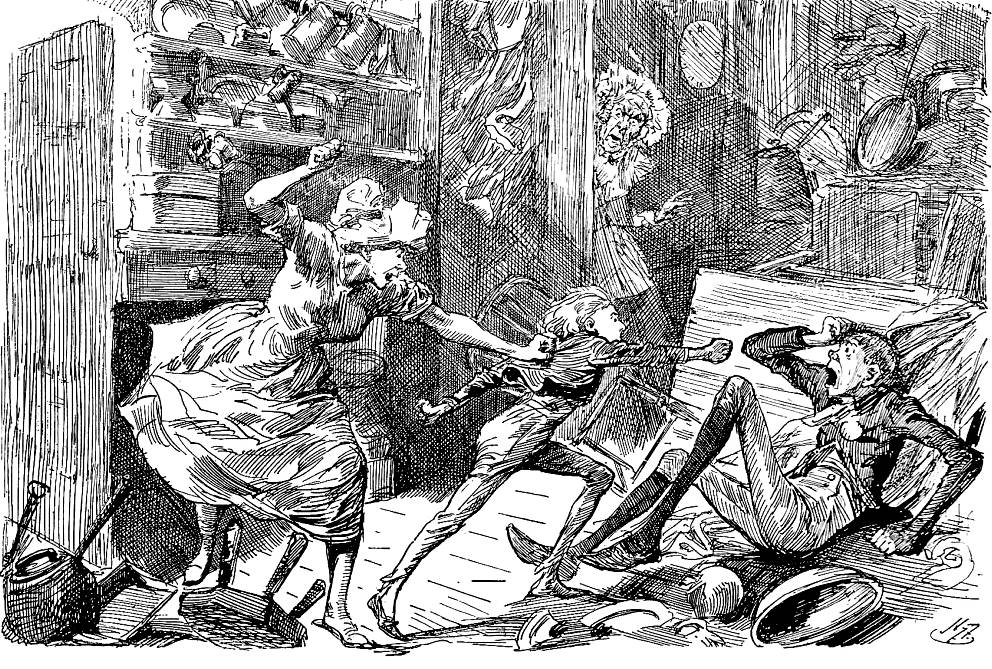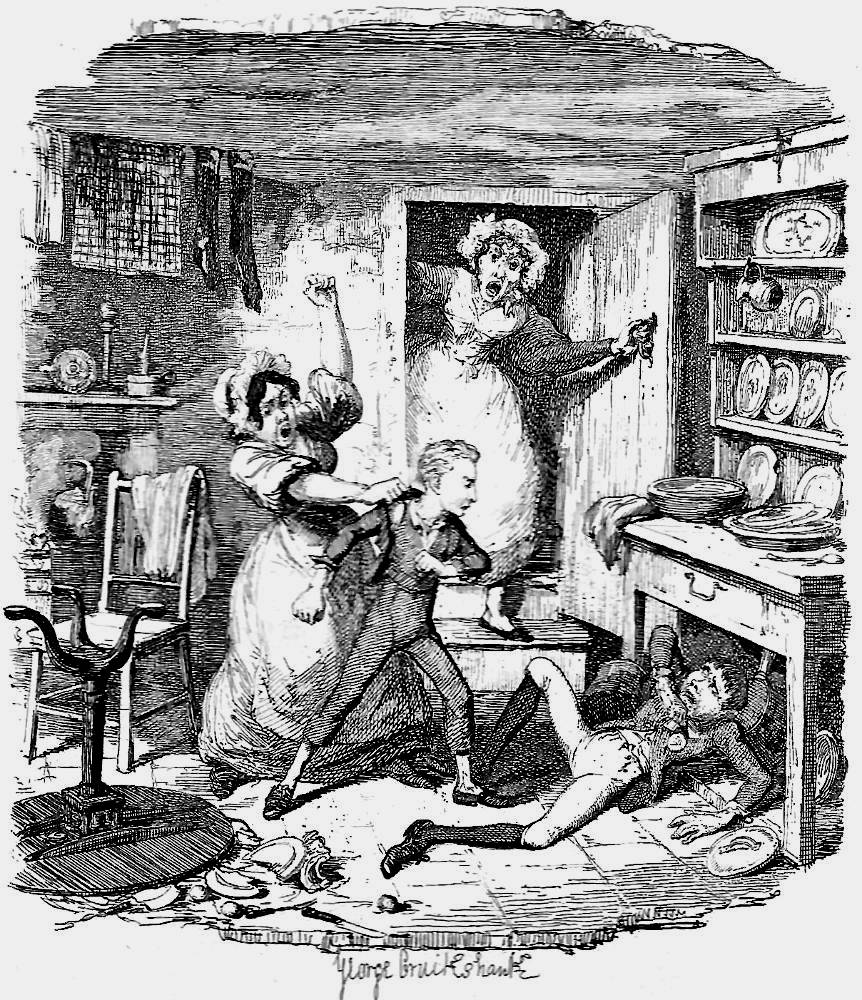
Oliver Aroused by Harry Furniss. Dickens's The Adventures of Oliver Twist, Charles Dickens Library Edition, facing III, 33. The illustration itself is positioned half-way through Chapter 5, although it alludes to an incident in Chapter 6. 1910. lithograph. 9.2 by 13.9 cm, framed.
The Charles Dickens Library Edition’s Long Caption
The cruel insult to his dead mother had set his blood on fire. The cowardly tormentor lay crouching at his feet. "He'll murder me!" blubbered Noah. "Charlotte! and missis! Here's the new boy a-murdering of me! Help! help! Oliver's gone mad! [43].
Context for the Illustration
"What did you say?" inquired Oliver, looking up very quickly.
"A regular right-down bad 'un, Work'us," replied Noah, coolly. "And it's a great deal better, Work'us, that she died when she did, or else she'd have been hard labouring in Bridewell, or transported, or hung; which is more likely than either, isn't it?"
Crimson with fury, Oliver started up; overthrew the chair and table; seized Noah by the throat; shook him, in the violence of his rage, till his teeth chattered in his head; and collecting his whole force into one heavy blow, felled him to the ground.
A minute ago, the boy had looked the quiet child, mild, dejected creature that harsh treatment had made him. But his spirit was roused at last; the cruel insult to his dead mother had set his blood on fire. His breast heaved; his attitude was erect; his eye bright and vivid; his whole person changed, as he stood glaring over the cowardly tormentor who now lay crouching at his feet; and defied him with an energy he had never known before.
"He'll murder me!" blubbered Noah. "Charlotte! missis! Here's the new boy a murdering of me! Help! help! Oliver's gone mad! Char — lotte!" [Chapter 6, "Oliver, Being Goaded by the Taunts of Noah, Rouses into Action, and Rather Astonishes Him," 42-43]
Commentary: Oliver's Indignation

Right: George Cruikshank's original version of Oliver plucks up a spirit.
The scene is one which Dickens himself selected for illustration by the resident artist of Bentley's Miscellany early in the 1837-39 serial run of the picaresque novel. Although the scene strikes one as melodramatic, with the underdog protagonist thoroughly thrashing the physically superior but cowardly bully, Noah Claypole, undertaker Sowerberry's other apprentice. However, Furniss transforms the scene to comedy with a spindly-shanked waif terrifying the loutish bully. The passage realised actually occurs ten pages later, so that one must read the the illustration proleptically, then flip back to it once one reaches page 43.The reader, even if unaware of the story's trajectory at this point, can anticipate that Oliver's being indentured to the local undertaker will be fraught with complications, despite his being a natural as a mute at funerals, and therefore a genuine asset to Sowerberry.This subject, like Oliver's asking for more and Oliver's narrowly escaping being apprenticed to a chimney-sweep, was one which Dickens directly proposed to his original illustrator George Cruikshank for Bentley's Miscellany as Oliver plucks up a spirit (see above: April 1837). At this point in concluding The Posthumous Papers of the Pickwick Club, that other Dickensian protagonist has been unjustly accused and pronounced guilty, and therefore liable to substantial damages, in the March 1837 instalment containing the courtroom scene The Trial (Chapter 34), so that Dickens seems to have been acutely aware of the essential unfairness of life as the bullies and manipulators get the better of his well-meaning central characters.
As the present subject suggests, Dickens realized that Cruikshank excelled at depicting violence and repressed emotion with explosive force, and grotesquerie such as Noah Claypole's grimacing. Cruikshank's organization of the dramatic scene is masterful, with each character in an appropriate pose, the juxtapositions of the four revealing their attitudes to one another, and the whole shaped into a pyramid with the wide-mouthed Mrs. Sowerberry (centre, rear) at the peak, the cowering, gangly-legged Noah at the base, right, and the overturned table drawing the eye to the left-hand corner. As in the accompanying narrative, Oliver in combative stance is centre, and the muscular Charlotte, trying to restrain him, left of centre. Thus, the original serial illustration (April 1837) and its re-issue in 1846 offered Furniss an excellent model, but also posed him a problem in that he could hardly simply copy the original engraving.
Cruikshank's serial illustration Oliver plucks up a spirit effectively captures the supporting attitudes of the other characters and the motivation of the protagonist; "the cruel insult to his dead mother had set his blood on fire" (43 in the Charles Dickens Library Edition). The broken plates (far left), balancing the cowering apprentice (far right), imply that he, too, is about to be broken or shattered by the force of Oliver's temper. The Household Edition illustrator, James Mahoney, likewise used the Cruikshank plate as a point of departure for Oliver rather astonishes Noah (see below).
In Mahoney's engraving, however, Oliver is not being restrained by a towering Charlotte and Mrs. Sowerberry has yet to come through the door, so that the focus in the 1871 Household Edition version is upon a victorious Oliver, standing coolly above the cowering and terrified bully, who lies on the floor amidst shards of shattered china. As is consistent with Mahoney's realistic style, the wood-engraving constitutes a close-up which focusses upon the contrasting reactions of three actors rather than, as in Cruikshank, the chaotic background, or in Furniss, the violent action caught in a freeze-frame, and the sheer terror on Noah's face. Everything in the Mahoney plate seems solid and three-dimensional, as if the reader is a member of an audience watching a theatrical action in which the mayhem has concluded and Oliver's indignation has subsided, so that the overall effect is realistic rather than, as in the other illustrators' treatments, hyperbolic and comical. The treatment of the subject in the Charles Dickens Library Edition is radically different.
Since Furniss enjoyed character comedy immensely, he delights in graphing the chaos that the diminutive Oliver has caused to the kitchen. His enemy, the surly Noah, cries out in terror as Oliver lunges towards him, his fist not quite reaching the bully because a much larger Charlotte has grabbed him by the collar. In the midst of this scene of wanton destruction, a sour-faced Mrs. Sowerberry is glaring are at adversaries from the central door. Everywhere the illustrator's exuberant use of swirling lines creates a sense of the tremendous energy that Noah's taunts have unleashed.
Illustrations from the Serial (1837), the Diamond Edition (1867), and the Household Edition (1910)


Left: Sol Eytinge, Junior's Diamond Edition wood-engraving of Charlotte and Noah absconding with the contents of Sowerberry's till, Noah and Charlotte (1867). Right: Clayton J. Clarke's watercolour version of Noah Claypole (c. 1900).

Above: James Mahoney's 1871 engraving of the enraged Oliver triumphing over the fallen bully, Oliver rather astonishes Noah..
Scanned image and text by Philip V. Allingham. [You may use this image without prior permission for any scholarly or educational purpose as long as you (1) credit the person who scanned the image and (2) link your document to this URL in a web document or cite the Victorian Web in a print one.].
Bibliography
Davis, Paul. Charles Dickens A to Z: The Essential Reference to His Life and Work. New York: Facts On File, 1998.
Dickens, Charles. The Adventures of Oliver Twist; or, The Parish Boy's Progress. Illustrated by George Cruikshank. London: Bradbury and Evans; Chapman and Hall, 1838; rpt. with revisions 1846.
_____. Oliver Twist. Works of Charles Dickens. Household Edition. 55 vols. Illustrated by F. O. C. Darley and John Gilbert. New York: Sheldon and Co., 1865.
_____. Oliver Twist. Works of Charles Dickens. Diamond Edition. 14 vols. Illustrated by Sol Eytinge, Jr. Boston: Ticknor and Fields, 1867.
_____. Oliver Twist. Works of Charles Dickens. Household Edition. 22 vols. Illustrated by James Mahoney. London: Chapman and Hall, 1871. Vol. I.
_____. The Adventures of Oliver Twist. Works of Charles Dickens. Charles Dickens Library Edition. 18 vols. Illustrated by Harry Furniss. London: Educational Book Company, 1910. Vol. III.
_____. The Adventures of Oliver Twist. Works of Charles Dickens. The Waverley Edition. Illustrated by Charles Pears. London: Waverley, 1912.
Forster, John. "Oliver Twist 1838." The Life of Charles Dickens. Ed. B. W. Matz. The Memorial Edition. 2 vols. Philadelphia: J. B. Lippincott, 1911. Vol. I, Book 2, Chapter 3.
Vann, J. Don. "Oliver Twist." Victorian Novels in Serial. New York: The Modern Language Association, 1985, 62-63.
Created 4 January 2015
Last modified 13 February 2020